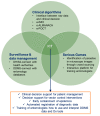Converging Human and Malaria Vector Diagnostics with Data Management towards an Integrated Holistic One Health Approach
- PMID: 29401670
- PMCID: PMC5858328
- DOI: 10.3390/ijerph15020259
Converging Human and Malaria Vector Diagnostics with Data Management towards an Integrated Holistic One Health Approach
Abstract
Monitoring malaria prevalence in humans, as well as vector populations, for the presence of Plasmodium, is an integral component of effective malaria control, and eventually, elimination. In the field of human diagnostics, a major challenge is the ability to define, precisely, the causative agent of fever, thereby differentiating among several candidate (also non-malaria) febrile diseases. This requires genetic-based pathogen identification and multiplexed analysis, which, in combination, are hardly provided by the current gold standard diagnostic tools. In the field of vectors, an essential component of control programs is the detection of Plasmodium species within its mosquito vectors, particularly in the salivary glands, where the infective sporozoites reside. In addition, the identification of species composition and insecticide resistance alleles within vector populations is a primary task in routine monitoring activities, aiming to support control efforts. In this context, the use of converging diagnostics is highly desirable for providing comprehensive information, including differential fever diagnosis in humans, and mosquito species composition, infection status, and resistance to insecticides of vectors. Nevertheless, the two fields of human diagnostics and vector control are rarely combined, both at the diagnostic and at the data management end, resulting in fragmented data and mis- or non-communication between various stakeholders. To this direction, molecular technologies, their integration in automated platforms, and the co-assessment of data from multiple diagnostic sources through information and communication technologies are possible pathways towards a unified human vector approach.
Keywords: One Health; diagnostics (Dx); epidemics; information and communication technologies (ICT); insecticide resistance; malaria; vector-borne diseases.
Conflict of interest statement
The authors declare no conflict of interest. The founding sponsors had no role in the design of the study; in the collection, analyses, or interpretation of data; in the writing of the manuscript, and in the decision to publish the results.
Figures




References
-
- WHO . World Malaria Report. World Health Organization; Geneva, Switzerland: 2017.
Publication types
MeSH terms
Substances
LinkOut - more resources
Full Text Sources
Other Literature Sources
Medical

